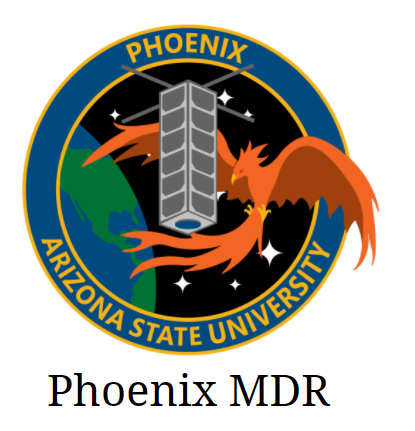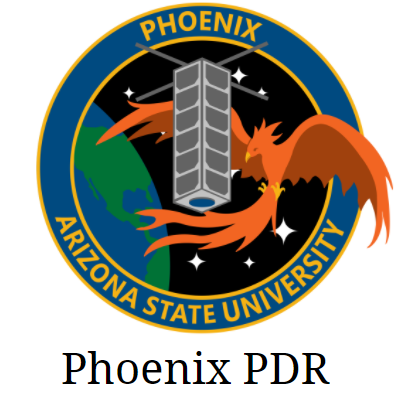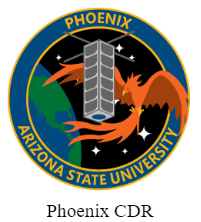Documents & Resources
General Resources
Phoenix Proposal
The Phoenix proposal, submitted to NASA USIP on November 20, 2015.
Phoenix Budget & Eqipment Breakdown
Two of each component (an engineering model and a flight unit) was purchased to facilitate development and reduce risk. As this was ASU's first student-led CubeSat project, funds also had to be allocated to developing a dedicated lab space for CubeSats. The link below details all components and equipment used to support the design, integration, and tesitng of Phoenix. It also details the cost breakdown of our hardware as well as lead times. We hope this spreadsheet can be a useful resource for other teams looking to understand how a budget can be allocated for projects like Phoenix, as well as what resources one may need to facilitate prototyping & hardware testing phases.
https://docs.google.com/spreadsheets/d/1hGPc8BuBvRMRXDrzl2fZDWMx8ayXvWSn...
Phoenix Requirements Verification Matrix
Details all requirements which dictated the deisgn of the Phoenix CubeSat, along with the method for verifying each of them.
34th Annual SmallSat Conference Paper (SSC20-WKII-04)
The paper submitted to the 34th annual SmallSat Conference outlines the design of the Phoenix CubeSat and mission status as of June 2020.
CubeSatBoK Podcast
The CubeSatBoK Podcast, which was developed by Ricky Tan and Richard Gibbons to share various lessons learned in CubeSat development. The podcast includes interviews with experts from industry and academia on topics related to leadership, FCC licensing, I&T and more.
The Art of Space Engineering Podcast
The Art of Space Engineering (TASE) is a podcast which aims to explore the details behind how spacecraft and various payloads come together before launch, and the lessons learned along the way. It features a few episodes on the student team's experience in developing the Phoenix CubeSat
- #3 - Phoenix Flight Software Part 1: Architecture, Software Development Lessons Learned
- #4 - Phoenix Flight Software Part 2: Systems Level Testing, Team Structure
- #5. - Phoenix Structures & Integration (Part 1): Structure Design & Integration Lessons Learned
- #6. - Phoenix Structures & Integration (Part 2): Flight Integration & Delivery
Episodes of TASE can be found on rss.com, as well as on Spotify, Apple Podcasts, and Google Podcasts.
CubeSat101 Guide
Developed by NASA to provide guidance to teams on various aspects of the CubeSat development process, such as development process, licensing procedures, launch preparation, and more.
The most recent version of the CubeSat101 guidebook, as well as links to other resources for licensing and launch specifications can be found here
Presentations
Successes, Failures, and Realities of Student CubeSat Development
Covers the team structure, scheduling/task tracking, successes, and failures and unexpected realities of developing the Phoenix CubeSat over the years. If you're interested in learning more about what working on CubeSat projects is like for other teams and what they have done to organize themselves and manage the project while being students, I hope you find this resource helpful.
Sierra Foothills ARC August 2020: Cubesats! The story of the ASU Phoenix Cubesat project
The Sierra Foothills ARC was privileged to have Devon and Trevor Bautista talk about their work on the Phoenix Cubesat as part of the Flight Software team. The two are graduate students at Arizona State University, and were involved with the program from shortly after conception, through deployment from the International Space Station, to operation afterward. In their talk, they review the objectives of the satellite, talk about its construction and their roles and challenges, and detail its current status. The video can be accessed here.
Working on a Mission Concept?
NASA's State of the Art Small Spacecraft Technology
NASA's state of the art report on small satellites goes into depth on the current capabilities of SmallSat/CubeSat hardware for a variety of spacecraft subsystems. It also describes what technology various hardware manufacturers offer and compares their capabilities between each of them. This document will be updated periodically by NASA, but the latest release as of October 2020 can be found here.
This is a really great read if you're just getting interested in SmallSats and want to know more about what the current capabilities and limitations are, or if you are working on hardware trade studies for a mission of your own.
Global Trends in Small Satellites Paper
Want to start a CubeSat project but have no idea what to do it on? If so, you may find this resource helpful. This paper highlights several areas that have been the focus of past mission concepts and describes scenarios of each. The paper covers topics such as optical communications, advances in propulsion, remote sensing, on orbit servicing, etc. It was published in 2017 and can be accessed here.
Venting Analysis for Pressurized Systems
FLIR Lens Venting Analysis
The lens of our camera is an airtight component. Pressurized systems like this need to be vented to survive the depressurization rates which occur during launch and ascent. This document details the team's calculation of the appropriate vent hole size, based on requirements documented in the Nanoracks IDD.
Communications Subsystem Resources
The following links are resources that the team found helpful for developing the spacecraft's communications subsystem
Jan King Link Budget Spreadsheets
Link budgets were calculated using the spreadsheets developed by Jan King. These were an excellent resource for the student team, and can be found here
The UHF link budget developed for Phoenix can be accessed here
The Phoenix link budget should be reviewed along with this report, which describes how losses are accounted for and why certain values were chosen.
Ground Station Hardware & Protocol Tutorial
Tutorial developed by Virginia Tech which explains various ground station setups, and outlines protocols such as AX.25 and KISS. This was an extremely helpful resource for understanding how to structure packets to the spacecraft, and is worth a look through if this information is unfamiliar to you.
FCC Licensing Materials
The documents provided below were submitted to or provided by the IARU, FCC, and ITU in an effort to acquire a frequency license for Phoenix. Obtaining a frequency license takes several months. CubeSat teams wishing to obtain a frequency license should start this process as soon as possible. Note: all materials were submitted based on the original spacecraft design, before the S-Band transmitter was descoped.
Section 5 of the CubeSat101 guide offers a detailed explanation of the overall licensing process as well as what materials are required for obtaining a frequency license. Please refer to the FCC and IARU websites for application templates and specific instructions, as these materials may be refined over time. Links to resources can be found in the CubeSat101 guide as well.
The resources included below serve to provide an example on how ground station and spacecraft characteristics were described during the application process, in case it may be of help to other CubeSat teams. The licenses are included as well to demonstrate what teams can expect these documents to look like.
Phoenix IARU Frequency Coordination Request
Document submitted to the IARU to obtain the operating frequency and frequency range that was to be allocated to Phoenix in the amateur radio bands. This was the first document submitted in the process of obtaining a frequency license. Following this, the team waited for the IARU frequency cooridnation grant before proceeding with gathering materials for the FCC.
Phoenix SpaceCap File & Frequency Licensing Tips
The following file details the SpaceCap file that was submitted to the FCC to obtain a frequency license for Phoenix, along with explanations on how this was filled out. In addition, it includes tips on securing a frequency license, based on the experience of the student team. To understand the process of securing a freqeuncy license, please refer to Section 5 of the CubeSat101 guide linked above.
IARU Frequency Coordination Grant
Letter from the IARU declaring the frequency Phoenix was allocated for its mission.
Phoenix FCC Experimental License
NOAA Remote Sensing License
The following documents were submitted to NOAA to coordinate a remote sensing license, which allows Phoenix to image the Earth.
These resources serve to provide a reference to other CubeSat teams on how structured our application and on how Phoenix was designed. For teams developing a remote sensing application, please refer to the application templates provided by NOAA for the specific content you must provide, as application requirements may be refined over time.
Phoenix NOAA Remote Sensing License Application
Phoenix Data Protection Plan
Describes how thermal images and satellite telemetry are handeled after being is transmitted from the spacecraft and received by the operations team. It also details what fault protection is enabled to keep operational control within the student team.
NOAA Non-Earth Imaging (NEI) Waiver Request
A waiver was requested from NOAA to allow Phoenix to collect images of non-Earth, such as the moon or the background of space to use for image calibration. The doucment includes the waiver request itself as well as follow-up questoins asked by NOAA on our imaging and tracking capabilities.
Conformal Coating, Staking, and Epoxy Resources
Conformal Coating & Staking Procedures
This document outlines a step-by-step procedure for preparing, making, and applying conformal coating and staking compounds. It also suggests materials to use for each procedure. This is what we used for outlining our conformal coating and staking processes. Note: Uralane = Arathane in this document. The technical datasheets for Arathane 5750 and 5753 can be found below.
Arathane 5750 - Conformal Coating Technical Datasheet
Technical datasheet for Arathane 5753, which Includes various technical specs, performance characteristics, and cure properties. If you don't want to dilute the conformal coating mixture, it is recommended that you follow the mix ratios outlined in this datasheet, rather than the above procedure.
Arathane 5750 (Parts A/B) is a common material used in the aerospace industry to prepare electronics boards for the space environment. Parts A and B are mixed together and applied to electronics as a coating to protect components from damage and mitigate outgassing. For tips on using Arathane 5750, have a look through the conformal coating & staking procedure posted above.
Arathane 5753 - Staking Compound Technical Datasheet
Technical datasheet for Arathane 5753, which Includes various technical specs, performance characteristics, and cure properties. If incorporating Cab-O-Sil (a hardening agent) into the staking mixture, it is better to follow the mix ratio outlined in the conformal coating/staking procedure document linked above. Not incorporating Cab-O-Sil will leave you with runny staking compound, which makes applying the compound more difficult.
Arathane 5753 is a common material used in the aerospace industry to solidify electrical and mechanical connections in spacecraft. It is typically applied on screw threads as a secondary locking feature, around wires to hold them together, and as a torque stripe on screw heads. For tips on applying Arathane 5753, please refer to the conformal coating and staking procedure posted above.
3M EC-2216 Epoxy Datasheet
Technical datasheet for 3M EC-2216 epoxy. Includes various technical specs, performance characteristics, mix ratios, and cure properties.
2216 is a common epoxy material used during the spacecraft integration process, when a very strong bond is necessary, that cannot be achieved with a screw or bolt interface. For example, Phoenix's ADCS required that a sun sensor was mounted to each face of the CubeSat to allow it to track the sun at all times. 2216 was used to mount a few of Phoenix's external sun sensors to its solar panels and UHF antenna, as these could not be mounted onto the hardware with screws.
It should be noted, however, that 2216 is extremely difficult to remove without risking damage to any hardware. Whlie Arathane can be removed with an XACTO knife, 2216 can only be removed by chemical means or by cutting into the material with a dremel, or something similar. Therefore, this material should not be used lightly.
Design Reviews
Design Reviews are meant to encompass the project after it has passed major milestones.There can be many forms of reviews, and projects normally have several of these throughout their development. Design reviews are formal reviews, moderated by a formal chair. Project teams hold these to prove they are meeting the requirements of the program, which is weighed and agreed upon by the review board
Phoenix MDR (November 2016)
 The Phoenix Mission Design Review, held in November 2016
The Phoenix Mission Design Review, held in November 2016
Phoenix PDR (March 2017)
 The Phoenix Preliminary Design Review (PDR), held in March 2017
The Phoenix Preliminary Design Review (PDR), held in March 2017
Phoenix CDR (June 2018)

The Phoenix Critical Design Review (CDR), held June 2018
